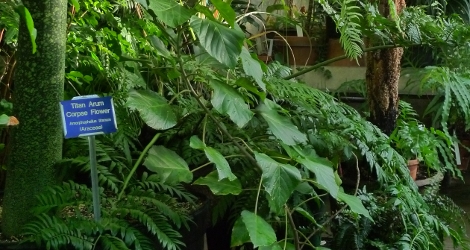Accession Data:
Equisetum diffusum D. Don
subg. Equisetum
- Common Name: Himalayan Horsetail
- Family: Equisetaceae Rich. ex DC
- Synonym(s): E. mekongense C. N. Page
- Country of Origin: Himalaya mountains from Simla (India) to Tibet

- Habitat: Open but shady, wet places; stream sides, mossy falls, wet meadows
- Description: This species, endemic in the Himalayas, is unlike all but E. bogotense in that the stems are seen above ground all year round.
Plants small to medium-sized. Rhizome creeping, erect, or ascending, blackish brown, nodes and roots with dense long yellowish brown trichomes or glabrous. Aerial stems annual, monomorphic, 10-30(-70) cm tall, 1-2 mm in diam. at middle, much branched; internodes 1.5-6 cm, green but those of lower 1-3 nodes blackish brown, not lustrous. Main stem 4-10-ridged; each side of ridge raised and forming edges reaching lower sheath teeth; each edge with a row of tubercles reaching sheath teeth; sheath tubes long, narrow, grayish green in lower portion, blackish brown in upper portion, with a deep groove going through back of sheath; sheath teeth 5-10, blackish brown, lanceolate, leathery, caudate at apex, persistent. Lateral branches slender, rigid, terete, 4-8-ridged; each side of ridge with edges and tubercles; sheath teeth 4-6, grayish green, deltoid, leathery, persistent. Strobilus terete, 1-9 cm, 4-8 mm in diam., apex blunt; stalk prolonged when mature and 1-3 cm.3
- Culture: May survive light freezes but best cultured in cool greenhouse. Does not die back, so also grows well in more tropical conditions.
Accession Data:
- Accession # 200202441
- Source: Chad Husby - FIU
- Accession Date: 10-04-2002
- Bench: 3319 - ZING:Canna & Musa
- Currently: active - healthy
- Qty: 1 confirmed on 12-04-2024
Classification:
- Division: Ferns
- Class: Polypodiopsida
- SubClass: Equisetopsidae
- Order: Equisetales
- SubOrder:
- Family: Equisetaceae
- SubFamily:
- Tribe:
- SubTribe:
Flowering Data:
This accession has been observed in bloom on:| Year | Jan | Feb | Mar | Apr | May | Jun | Jul | Aug | Sep | Oct | Nov | Dec | ||||||||||||||||||||||||||||||||||||||||
|---|---|---|---|---|---|---|---|---|---|---|---|---|---|---|---|---|---|---|---|---|---|---|---|---|---|---|---|---|---|---|---|---|---|---|---|---|---|---|---|---|---|---|---|---|---|---|---|---|---|---|---|---|
| 2025 | ||||||||||||||||||||||||||||||||||||||||||||||||||||
| 2024 | ||||||||||||||||||||||||||||||||||||||||||||||||||||
| 2023 | ||||||||||||||||||||||||||||||||||||||||||||||||||||
| 2022 | ||||||||||||||||||||||||||||||||||||||||||||||||||||
| 2021 | ||||||||||||||||||||||||||||||||||||||||||||||||||||
| 2020 | ||||||||||||||||||||||||||||||||||||||||||||||||||||
| 2019 | ||||||||||||||||||||||||||||||||||||||||||||||||||||
| 2018 | ||||||||||||||||||||||||||||||||||||||||||||||||||||
| 2017 | ||||||||||||||||||||||||||||||||||||||||||||||||||||
| 2016 | ||||||||||||||||||||||||||||||||||||||||||||||||||||
References (internal):
- EEB Greenhouse Holdings native to: China South-Central / China North-Central / China Southeast / Japan / East Himalaya / India / Nepal / Pakistan / West Himalaya / Myanmar / Vietnam
References (external):
- The Plant List (2013). Version 1.1. Last accessed on Monday, February 19, 2018.
- Wonderful World of Equisetum - last visited 8 OCT 2002
- Flora of China. Last accessed on Friday, 10 May, 2019.
data regenerated on Sat, 25 Jan 2025 09:57:02 -0500 [bcm v4.0]
Images:

Additional images for this accession:
Click on thumbnails to enlargeCurrent Accessions in the Equisetaceae
- Equisetum bogotense

- Equisetum bogotense W/C

- Equisetum bogotense

- Equisetum bogotense W/C

- Equisetum diffusum

- Equisetum x font-queri W/C
- Equisetum giganteum W/C
- Equisetum hyemale

- Equisetum laevigatum

- Equisetum x moorei W/C
- Equisetum myriochaetum


- Equisetum pratense W/C

- Equisetum ramosissimum

- Equisetum scirpoides
- Equisetum telmateia ssp. braunii W/C

- Equisetum telmateia ssp. braunii W/C

- Equisetum telmateia ssp. telmateia
- Equisetum variegatum 'Large Form'
- Equisetum variegatum W/C
- Equisetum variegatum ssp. alaskanum
- Equisetum variegatum var. majus W/C
- Equisetum variegatum var. wilsoni W/C
- Equisetum xylochaetum W/C

 = indicates flowering in past 14 days
= indicates flowering in past 14 days
 = images available for this accession
= images available for this accession
 = map available for this accession
= map available for this accession
 = accession added within past 90 days
= accession added within past 90 days